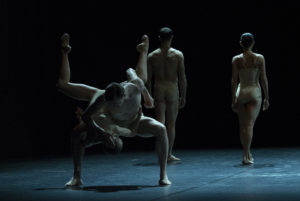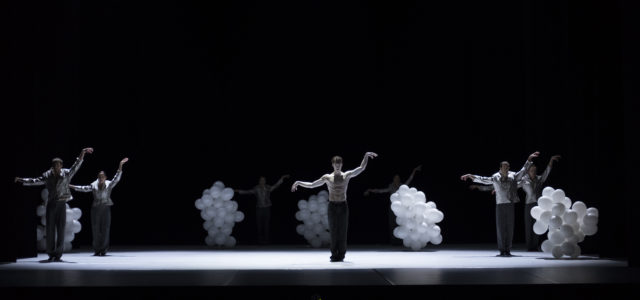
For the English version, please, scroll down
BERLINO – Ieri sera, presso la Komische Oper Berlin, serata dedicata alla danza d’autore. In scena i pezzi di Doda, Goecke e Duato.
Ad aprire la serata è Was Bleibt, lavoro del coreografo albanese appositamente creato per lo Staatsballett Berlin.
Sul palco i danzatori si muovono veloci tra le corde bianche che scendono dall’alto e che definiscono lo spazio in anguste geometrie.
Dopo pochissimo, il sipario si chiude e quando, dopo pochi secondi, si riapre, tutti i danzatori sono raggruppati in uno spazio delimitato dagli elastici che pendono dal soffitto. Di nuovo nero e, alla riapertura, in scena regna il chaos. I danzatori si muovono agili in una danza plastica e dinamica. Ancora buio e poi un cono di luce illumina una donna. Molto lentamente, tutti gli altri danzatori la raggiungono per creare un gruppo compatto dal quale inizieranno poi le differenti composizioni coreografiche.
Da qui il pezzo è un po’ lento, ma non mancano spunti interessanti e momenti di danza molto belli.
A conclusione dello spettacolo le corde cadono verticalmente, quasi come se l’ordine fosse ricomposto, le difficoltà superate, l’armonia raggiunta.
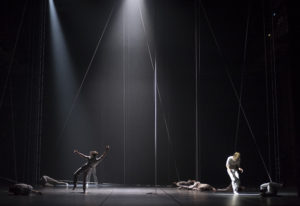
Il Pierrot lunaire è una creazione del 2010 di Marco Goecke per il Ballet Scapino di Rotterdam.
Il lavoro, come si intuisce dal titolo, è basato sulla figura poetica della Commedia dell’Arte: il triste clown dal cuore spezzato.
Nel pezzo di Goecke, Pierrot si muove – nello stile inconfondibile del coreografo tedesco – con passettini veloci, muovendo le braccia ampie in una gestualità che ricorda un uccello dalle ali spezzate.
Pierrot è disperato perché il suo amore per Colombina non è corrisposto e la luna – simboleggiata da palloncini bianchi – diventa la sua ossessione. Circondato da sette demoni che vagano dentro e fuori dall’ombra, Kostantin Lorenz, con grande espressività, da vita a un Pierrot fragile, disperato e romantico.
Coinvolgente e intenso, il pezzo di Goecke è la punta di diamante della serata.
Di grande effetto è anche la musica del compositore d’avanguardia austriaco Arnold Schoenberg (1874-1951), basata sul ciclo di 21 poesie di Albert Giraud (1884) e tradotta in tedesco da Otto Erich Hartleben.
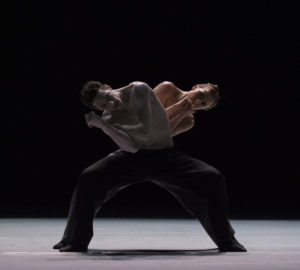
‘Por vos muero’, coreografia di Nacho Duato, è un omaggio alla musica del Siglo de oro(XV e XVI secolo) in Spagna.
Il titolo, come anche la lettura del testo che accompagna la narrazione, è tratto dai versi di Garcilaso de la Vega: “Per te ho vita, / per te devo morire / e per te io muoio”.
La danza di stile neoclassico, piena di tecnica e virtuosismi, mette in luce l’abilità dei ballerini.
L’uso delle maschere sembra un tributo a Kylian.
Lavoro non certo originale e innovativo, ma di grande bellezza estetica, che conquista il pubblico in sala.
Nicola Campanelli
iscriviti alla newsletter di Campadidanza
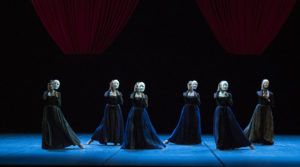
English version
Yesterday evening, at the Komische Oper Berlin, the evening was dedicated to three pillars of the dance world: Doda, Goecke and Duato.
To open the evening it’s Was Bleibt, a work by the Albanian choreographer specially created for the Staatsballett Berlin.
On stage, the dancers move fast between white strings that descend from above and divide the space in narrow geometric shapes.
After a short time since the beginning of the show, the curtain closes and when, after a few seconds, it opens again, all the dancers are now gathered between elastic bands that hang from the ceiling. Shortly after, the lights fade out, at when they fade back on, the chaos reigns on stage. The dancers move smoothly in a plastic and dynamic dance. The stage goes dark once again until a cone of light illuminates a woman. Very slowly, all the other dancers join her to create a compact group from where the different choreographic compositions start.
From here the piece is a bit ‘slow, but there are several interesting ideas and very beautiful dance moments.
At the end of the show the strings fall vertically, maybe symbolizing that the order is recomposed, the difficulties overcome, the harmony re-achieved.
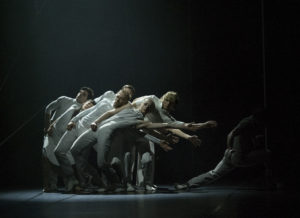
Pierrot lunaire is a 2010 creation by Marco Goecke for the Rotterdam Ballet Scapino.
The work, as you can guess from the title, is based on the poetic figure of the Commedia dell’Arte: the sad clown with a broken heart.
In the piece of Goecke, Pierrot moves – in the unmistakable style of the German choreographer – with quick little steps, moving the wide arms with gestures that remind a bird with broken wings.
Pierrot is desperate because his love for Colombina is unreturned and the moon – symbolized by white balloons – becomes his obsession. Surrounded by seven demons that roam in and out of the shadows, Kostantin Lorenz, with great expressiveness, gives life to a fragile, desperate and romantic Pierrot.
Addictive and intense, the piece of Goecke is the highlight of the evening.
Really remarkable as well, is the music of the Austrian avant-garde composer Arnold Schoenberg (1874-1951), based on the 21 poems cycle by Albert Giraud (1884) and translated into German by Otto Erich Hartleben.
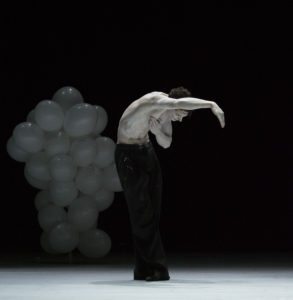
‘Por vos muero‘, choreography by Nacho Duato, is a tribute to the music of the Siglo de oro (XV and XVI centuries) in Spain.
The title, as well as the reading of the text that accompanies the narration, is taken from the verses of Garcilaso de la Vega: “For you I live, / for you I must die / and for you I die”.
The neoclassical style, full of technique and virtuosity, highlights the ability of the dancers.
The use of masks seems a tribute to Kylian.
The piece – certainly not original and innovative – is aesthetically beautiful and absolutely conquers the audience.
